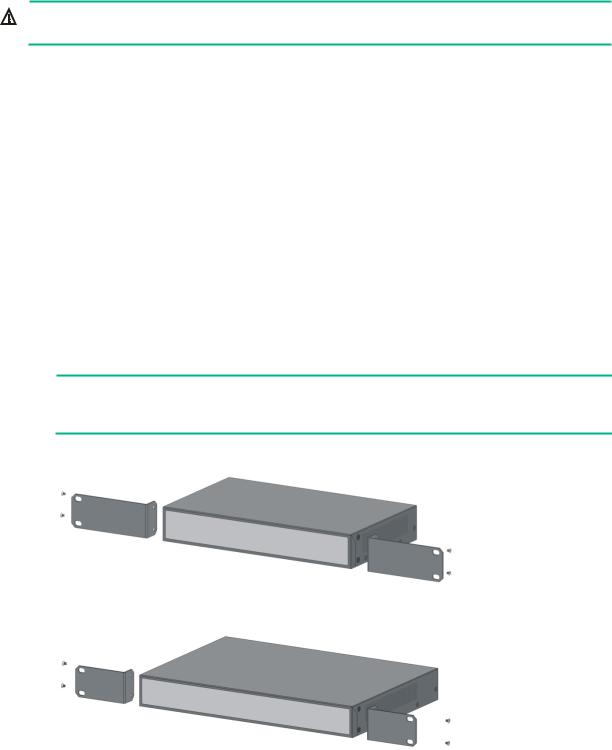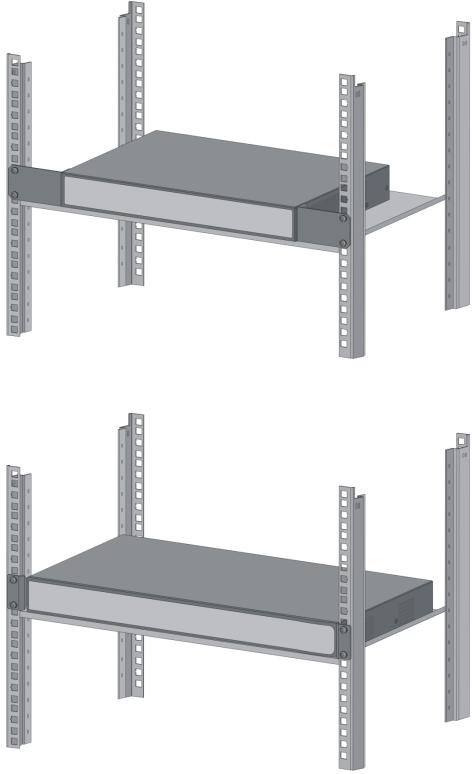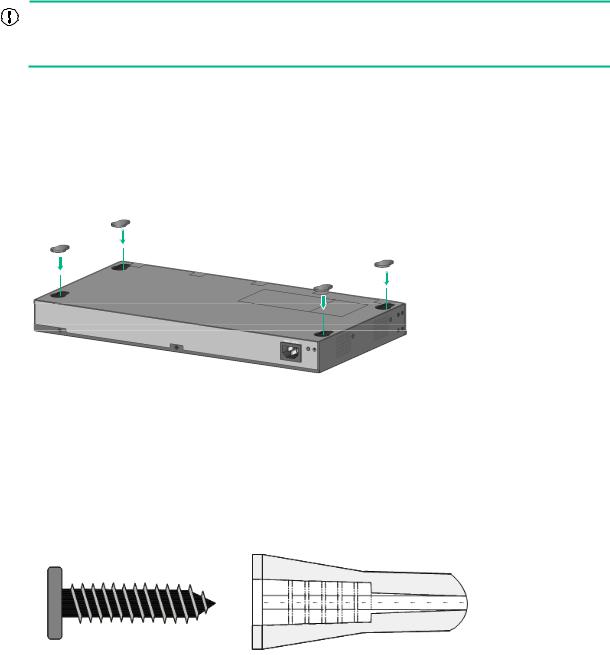HP OfficeConnect 1920 8G User Manual

HPE OfficeConnect 1920 Switch Series
Getting Started Guide
Part number: 5998-7148R
Document version: 6W103-20160324
© Copyright 2016 Hewlett Packard Enterprise Development LP
The information contained herein is subject to change without notice. The only warranties for Hewlett Packard Enterprise products and services are set forth in the express warranty statements accompanying such products and services. Nothing herein should be construed as constituting an additional warranty. Hewlett Packard Enterprise shall not be liable for technical or editorial errors or omissions contained herein.
Confidential computer software. Valid license from Hewlett Packard Enterprise required for possession, use, or copying. Consistent with FAR 12.211 and 12.212, Commercial Computer Software, Computer Software Documentation, and Technical Data for Commercial Items are licensed to the U.S. Government under vendor’s standard commercial license.
Links to third-party websites take you outside the Hewlett Packard Enterprise website. Hewlett Packard Enterprise has no control over and is not responsible for information outside the Hewlett Packard Enterprise website.
Acknowledgments
Intel®, Itanium®, Pentium®, Intel Inside®, and the Intel Inside logo are trademarks of Intel Corporation in the United States and other countries.
Microsoft® and Windows® are trademarks of the Microsoft group of companies. Adobe® and Acrobat® are trademarks of Adobe Systems Incorporated.
Java and Oracle are registered trademarks of Oracle and/or its affiliates. UNIX® is a registered trademark of The Open Group.
Contents
Preparing for installation ················································································· 1
Safety recommendations ···································································································································1 Examining the installation site····························································································································2 Temperature/humidity ································································································································2 Cleanliness·················································································································································2 EMI·····························································································································································3
Installing the switch························································································· 4
Mounting the switch in a 19-inch rack by using mounting brackets ···································································4 Mounting the switch on a workbench·················································································································7 Mounting the switch on a wall ····························································································································7 Connecting cables ·············································································································································9 Connecting network cable··························································································································9 Installing the SFP transceiver module and optical fibers ···········································································9 Connecting the console cable ··················································································································10 Connecting the AC power cord ················································································································10 Connecting the DC power cord ················································································································11 Verifying the installation ···································································································································12
Accessing the switch for the first time··························································· 13
Setting up the configuration environment ········································································································13 Connecting the console cable··························································································································13 Console cable ··········································································································································13 Connection procedure······························································································································14 Setting terminal parameters·····························································································································14 Powering on the switch ····································································································································14 Verification before power-on ····················································································································14 Powering on the switch ····························································································································14
Document conventions and icons ································································· 16
Conventions ·····················································································································································16 Network topology icons····································································································································17
Support and other resources ········································································ 18
Accessing Hewlett Packard Enterprise Support ······························································································18 Accessing updates···········································································································································18 Websites ··················································································································································19 Customer self repair·································································································································19 Remote support········································································································································19 Documentation feedback ·························································································································20
Appendix A Chassis views and technical specifications ······························· 21
Chassis views ··················································································································································21 HPE 1920 8G ···········································································································································21 HPE 1920 16G ·········································································································································21 HPE 1920 24G ·········································································································································22 HPE 1920 48G ·········································································································································22 HPE 1920 8G PoE+ (65W) ······················································································································23 HPE 1920 8G PoE+ (180W) ····················································································································23 HPE 1920 24G PoE+ (180W) ··················································································································24 HPE 1920 24G PoE+ (370W) ··················································································································24 HPE 1920 48G PoE+ (370W) ··················································································································25
Physical specifications ·····································································································································25 Chassis dimensions and weights ·············································································································25 Ports and interface card slots···················································································································26 Environmental specifications ···························································································································26 Power specifications ········································································································································26
i
AC input voltage specifications ················································································································26 RPS DC input voltage specifications and RPS compatibility ···································································27 Power consumption specifications for non PoE switches ········································································27 Power consumption specifications for PoE switches ···············································································27 Cooling system ················································································································································28
Appendix B LEDs·························································································· 29
Power LED ···············································································································································29 Copper port LEDs ····································································································································29 Fiber port LEDs ········································································································································29 RPS LED··················································································································································30 Copper port mode LED ····························································································································30
Appendix C Troubleshooting········································································· 31
ii

Preparing for installation
The HPE OfficeConnect 1920 Switch Series includes models listed in Table 1.
Table 1 HPE OfficeConnect 1920 Switch Series models
Product code |
HPE description |
Alias |
|
Non PoE |
|
|
|
JG920A |
HPE OfficeConnect 1920 8G Switch |
HPE 1920 8G |
|
JG923A |
HPE OfficeConnect 1920 16G Switch |
HPE 1920 16G |
|
JG924A |
HPE OfficeConnect 1920 24G Switch |
HPE 1920 24G |
|
|
|
|
|
JG927A |
HPE OfficeConnect 1920 48G Switch |
HPE 1920 48G |
|
|
|
|
|
PoE |
|
|
|
JG921A |
HPE OfficeConnect 1920 8G PoE+ |
HPE 1920 8G PoE+ |
|
(65W) Switch |
(65W) |
||
|
|||
JG922A |
HPE OfficeConnect 1920 8G PoE+ |
HPE 1920 8G PoE+ |
|
(180W) Switch |
(180W) |
||
|
|||
JG925A |
HPE OfficeConnect 1920 24G PoE+ |
HPE 1920 24G PoE+ |
|
(180W) Switch |
(180W) |
||
|
|||
JG926A |
HPE OfficeConnect 1920 24G PoE+ |
HPE 1920 24G PoE+ |
|
(370W) Switch |
(370W) |
||
|
|||
JG928A |
HPE OfficeConnect 1920 48G PoE+ |
HPE 1920 24G PoE+ |
|
(370W) Switch |
(370W) |
||
|
RMN
HNGZA-HA0008
HNGZA-HA0011
HNGZA-HA0012
HNGZA-HA0015
HNGZA-HA0009
HNGZA-HA0010
HNGZA-HA0013
HNGZA-HA0014
HNGZA-HA0016
IMPORTANT:
For regulatory identification purposes, the switches are assigned Regulatory Model Numbers (RMNs). The RMNs should not be confused with the marketing name HPE 1920, or the product codes.
Safety recommendations
To avoid any equipment damage or bodily injury, read the following safety recommendations before installation. The recommendations do not cover every possible hazardous condition.
•To avoid damage to the electrolytic capacitor in the switch, do not store the switch without power for more than one year.
•Before cleaning the switch, remove all power cords from the switch. Do not clean the switch with a wet cloth or liquid.
•Do not place the switch near water or in a damp environment. Prevent water or moisture from entering the switch chassis.
•Do not place the switch on an unstable case or desk. The switch might be severely damaged in case of a fall.
•Ensure good ventilation of the equipment room and keep the air inlet and outlet vents of the switch free of obstruction.
•Make sure the operating voltage is in the required range.
•To avoid electrical shocks, do not open the chassis while the switch is operating or when the switch is just powered off.
1
•The accessories shipped with the switch, including but not limited to power cables, are intended only for the switch. Please do not use them for other products.
Examining the installation site
The switches must be used indoors. You can mount your switch in a rack or on a workbench, but make sure:
•A minimum clearance of 5 cm (1.97 in) is reserved at the air inlet and exhaust vents for ventilation.
•The rack or workbench has a good ventilation system.
•The rack or workbench is sturdy enough to support the switch and its accessories.
•The rack or workbench is reliably grounded.
To ensure correct operation and long service life of your switch, install it in an environment that meets the requirements described in the following subsections.
Temperature/humidity
Maintain temperature and humidity in the equipment room as described in "Environmental specifications."
•Lasting high relative humidity can cause poor insulation, electricity creepage, mechanical property change of materials, and metal corrosion.
•Lasting low relative humidity can cause washer contraction and ESD and cause problems including loose mounting screws and circuit failure.
•High temperature can accelerate the aging of insulation materials and significantly lower the reliability and lifespan of the switch.
Cleanliness
Dust buildup on the chassis might result in electrostatic adsorption, which causes poor contact of metal components and contact points, especially when indoor relative humidity is low. In the worst case, electrostatic adsorption can cause communication failure.
Table 2 Dust concentration limit in the equipment room
Substance |
Concentration limit (particles/m³) |
Dust |
≤ 3 x 104 (no visible dust on the tabletop over three days) |
NOTE: |
|
Dust diameter ≥ 5 μm |
|
The equipment room must also meet strict limits on salts, acids, and sulfides to eliminate corrosion and premature aging of components, as shown in Table 3.
Table 3 Harmful gas limits in the equipment room
Gas |
Maximum concentration (mg/m3) |
SO2 |
0.2 |
H2S |
0.006 |
NH3 |
0.05 |
|
|
Cl2 |
0.01 |
|
|
2
EMI
All electromagnetic interference (EMI) sources, from outside or inside of the switch and application system, adversely affect the switch in the following ways:
•A conduction pattern of capacitance coupling.
•Inductance coupling.
•Electromagnetic wave radiation.
•Common impedance (including the grounding system) coupling. To prevent EMI, perform the following tasks:
•If AC power is used, use a single-phase three-wire power receptacle with protection earth (PE) to filter interference from the power grid.
•Keep the switch far away from radio transmitting stations, radar stations, and high-frequency devices.
•Use electromagnetic shielding when necessary. For example, use shielded interface cables.
3

Installing the switch
WARNING!
Before installing or moving the switch, remove the power cord.
You can install an HPE 1920 switch in a 19-inch rack, on a workbench, or on a wall.
Mounting the switch in a 19-inch rack by using mounting brackets
1.Wear an ESD wrist strap and make sure it makes good skin contact and is reliably grounded.
2.Verify that the rack is securely grounded and is stable.
3.Select mounting brackets for the switch.
{The HPE 1920 8G switch uses Type-A mounting brackets, as shown in Figure 1.
{The HPE 1920 8G PoE+ (65W) and 1920 8G PoE+ (180W) switches use Type-B mounting brackets, as shown in Figure 2.
{The HPE 1920 16G, 1920 24G, 1920 24G PoE+ (180W), 1920 24G PoE+ (370W), 1920 48G, and 1920 48G PoE+ (370W) switches use Type-C mounting brackets, as shown in Figure 3.
4.Attach the mounting brackets to both sides of the chassis with screws.
NOTE:
Mounting brackets are used only for securing the switch to the rack. A rack shelf on the rack is used to bear the switch weight.
Figure 1 Attaching Type-A mounting brackets to the switch
Figure 2 Attaching Type-B mounting brackets to the switch
4

Figure 3 Attaching Type-C mounting brackets to the switch
5.Place the switch on a rack shelf in the rack. Push the switch in until the oval holes in the brackets align with the mounting holes in the rack posts.
6.Attach the mounting brackets to the rack posts with screws.
Figure 4 Attaching Type-A mounting brackets to the rack post
5

Figure 5 Attaching Type-B mounting brackets to the rack post
Figure 6 Attaching Type-C mounting brackets to the rack post
6

Mounting the switch on a workbench
IMPORTANT:
•Reserve a clearance of 10 cm (3.9 in) around the chassis for heat dissipation.
•Do not place heavy objects on the switch.
To mount the switch on a workbench:
1.Verify that the workbench is sturdy and reliably grounded.
2.Place the switch bottom up, and clean the round holes in the chassis bottom with a dry cloth.
3.Attach the rubber feet to the four round holes in the chassis bottom.
4.Place the switch upside up on the workbench.
Figure 7 Attaching rubber feet (HPE 1920 24G PoE+ Switch)
Mounting the switch on a wall
Only the HPE 1920 8G switch can be installed on a wall. The type of screws used to mount the switch on the wall depends on the wall type. This section uses a concrete wall as an example.
Wall-mounting anchor kits are user supplied. The screws must be a minimum of 3 mm (0.12 in) in diameter, and the screw head must be a minimum of 6 mm (0.24 in) in diameter.
Figure 8 Wall-mounting anchor kit
To install the switch on a concrete wall:
1.Drill two holes at the same height. Make sure the spacing in between is 160 mm (6.30 in), as shown in Figure 9.
The hole depth and diameter depend on the wall anchors and screws you use. Make sure you can push the anchors to their full depth in the holes.
7
